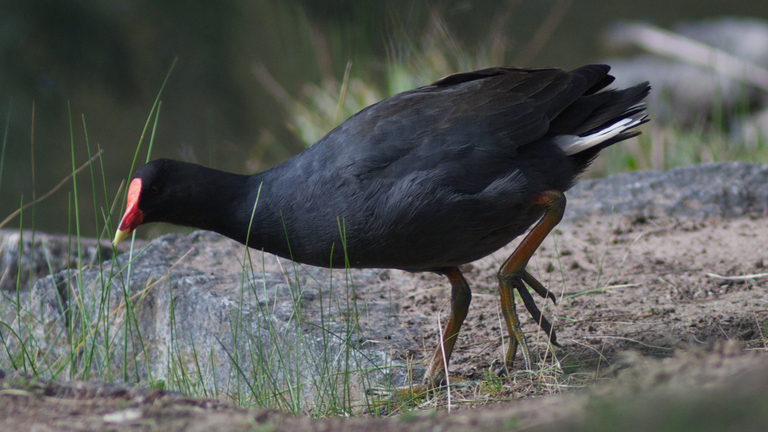Each month I will reproduce my Nature Diary Articles from the Hepburn Advocate – Here is last month’s! : )
The wonderful thing about researching an article about very common and everyday animals is that sometimes your mind is just blown away by an insight into the fascinating lives of a bird or mammal you have been looking at your whole life. For example, the Dusky Moorhen, or as I now call it – the “Frisky Moorhen”!
The Dusky Moorhen is a species you will probably encounter at just about any human-created water body that has native vegetation and a few trees. Dusky Moorhens are a type of rail or crake – not a duck, and their genus name Gallinula means ‘little hen’ in Latin. Two other water hen species are similar to the Dusky Moorhen but can be easily distinguished. The similarly-sized Eurasian Coot, Fulica atra, has a white bill and face shield and a red eye. The Purple Swamphen, Porphyrio porphyrio, is much larger and has a distinct purple-blue colouring.
Dusky Moorhens have large feet with enormous toes, a dark-coloured body and a red bill with yellow tip, and reddish orange headpiece called a frontal shield. The Moorhens walk slowly and deliberately – high-stepping and placing their feet carefully as they forage for grasses by the shore. When they swim they jerk their head forwards like a pigeon. Their calls are very accurately described as “loud, sharp gutteral crowing or harsher repeated shrieks”. Ear-splitting!
Now I have seen these birds for years raising their cute chicks, little fluffy “ mini-me’s” with huge feet. I did not realise that the Dusky Moorhen actually lives an alternative lifestyle that forgoes monogamy utterly – kind of like a radical hippy commune from the early seventies. They form breeding groups of seven or eight birds, and all the males will mate with all females. All the adults in the group build nests, defend territory and feed the young. The bonds between parents and young are maintained equally by all birds in the group until the young are independent.
Cooperative breeding is common in Australian birds, such as fairy-wrens, choughs and kookaburras, and in these cases it is mostly the males from previous years who stick around to help raise the next brood of young. With “Frisky Moorhens”, this is a group of completely unrelated adults coming together to raise their young as a collective.
Members of a breeding group take defence of the breeding territory very seriously indeed. At the boundary of the territory the home bird will display to the intruder bird, usually this is enough for a mutual back down. If the intruder will not give, the home bird attacks it with its beak, usually on the neck and hold it submerged underwater! The intruder usually gets the signal and leaves by this point. If the intruder is determined and will not yield, or the home bird cannot get a grip on its neck, then both birds raise up and kick each other’s breast with both feet.
So this spring when you see a group of Dusky Moorhens at your local lake, watch a while – there is definitely more going here than initially meets the eye!

0 Comments